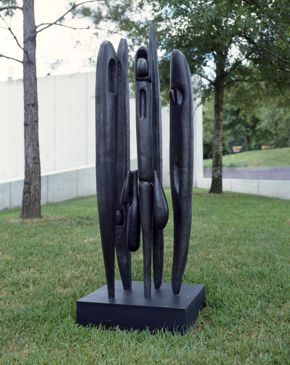A Confessional Sculpture by Louise Bourgeois March 15, 2017

Louise Bourgeois, Quarantania I, 1947–53/1981 (cast in 1984), bronze with bronze base, ed. 4/6, the Museum of Fine Arts, Houston, Museum purchase. © Louise Bourgeois Trust/Licensed by VAGA, New York, NY
In March, the Museum celebrates Women’s History Month by highlighting works of art that help you answer the question “Can you name #5WomenArtists?”
French-American artist Louise Bourgeois (1911–2010) put her emotional life at the center of her art by incorporating autobiographical imagery inspired by childhood trauma. Bourgeois was born in France, where her parents ran a tapestry-restoration business. Her childhood home was turbulent: Her flighty father was often unfaithful to her mother, most painfully with the young artist’s English governess.
In 1938 Bourgeois moved to New York with her husband, art historian Robert Goldwater. Convinced that she could not conceive a child, they returned briefly to France to adopt a French boy, Michel. Within a year, in 1940, she had given birth to another son, Jean-Louis, and in 1941 another, Alain.
The Story behind Quarantania I
Bourgeois’s sculpture in the Museum’s Cullen Sculpture Garden, Quarantania I, draws from these experiences. Although she never specifically commented on the title, Quarantania I is a reference to the word “quarantine,” or a recovery from an illness with 40 days spent alone away from other people. Between 1947 and 1953, Bourgeois created the sculpture’s five totem-like figures, which she called Personages, to help exorcize her homesickness. The Personages may represent her acquaintances; perhaps Bourgeois, her husband, and three sons; or possibly their friends and family left behind in France when she moved to the United States. The shapes resemble sewing needles or weaving shuttles—a reference to the tools of her family’s tapestry-restoration trade.
Woman at the Center
The four upright Personages surround—and perhaps protect—the central figure, which can be interpreted as a self-portrait; later, Bourgeois reworked this central figure and gave it the individual title of Woman with Packages, a reference to women’s selfless contributions as the caregivers of the future generation and to the numerous sacrifices involved. Her perception of the human figure is poignant as she explores the relationship of the child to the family, and of the individual to the group.
The human scale of the sculpture and the placement of the figures on a platform on the ground level invite you to interact with the group and to engage in a confessional artistic experience.
Learn more about the #5WomenArtists campaign, and see this sculpture in the Cullen Sculpture Garden—always free to visit, the Cullen Sculpture Garden is open every day.





